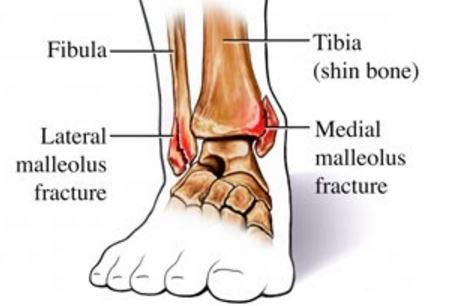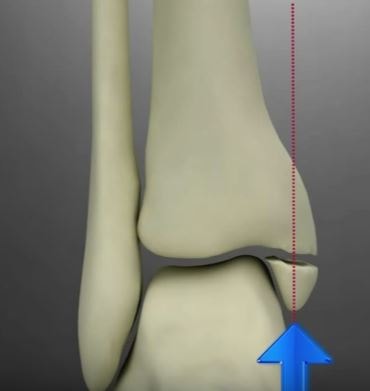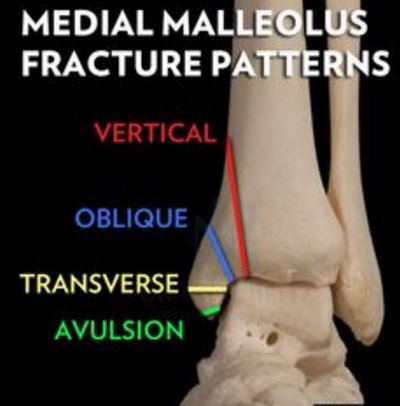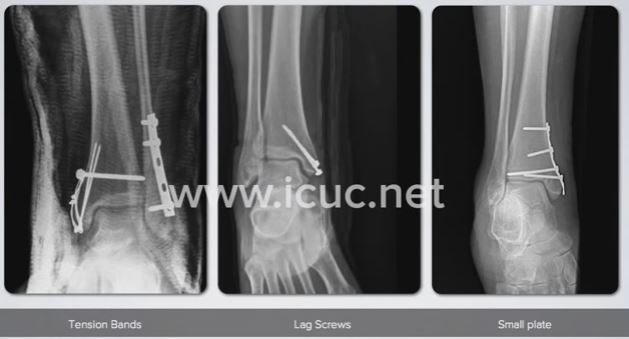Medial Malleolus Fracture
Introduction
The ankle joint is one of the most common joints that gets fractured and it ranges from a simple fracture of one bone to the displacement of the ankle [1].

Medial Malleolus
There are 3 bones that comprises the ankle joint: the tibia or shinbone, fibula and the talus. The medial malleolus is the bony prominence that is found in the inside of the ankle. This bump is the end of the tibia and is also the attachment of the deltoid ligament. These structures form the ankle’s inner support. Figure 1 shows the medial malleolus [1, 2, 3].
What is Medial Malleolus Fracture?
Certain activities such as landing from a jump or rolling on an ankle place stress on the medial malleolus and other structures in the ankle. When this stress is greater than what the bone can tolerate, this will cause a fracture in this bony prominence.

A medial malleolus fracture often happens with other foot, leg, or ankle injuries because of the large amount of force that is required to break the tibia [3].

ICD10
The ICD10 diagnosis code that is used for the fracture of medial malleolus is S82.5. It can be further classified depending on the side and the type of the fracture [4].
Causes
Sports Injuries
Sports injuries is the primary cause of this fracture. Twisting or rotating the ankle may cause fracture of the medial malleolus associated with running and jumping sports. It may also happen to players of sports that include changing of directions while running such as basketball, football, soccer and rugby. Stress fracture of this area due to overuse is seen with athletes who do a lot of running [3].
Other Causes
Fracture of the medial malleolus may result from a fall or a direct blow to the inner part of the lower leg or ankle. This injury may also be obtained following an impact during a vehicular accident [3, 5].
Signs and Symptoms
The first symptom felt after the injury is a sharp, intense pain in the inner ankle or lower leg. The pain may also increase when the foot or ankle is being moved. There may be times that the symptoms may be experienced in the Achilles and calf area [3].
If there is a displaced fracture, weight bearing on the affected leg may not be possible. Other symptoms that may be present are bruising, swelling and tenderness on the affected region. In severe types of this injuries, a deformity may be noticeable on the bony prominence [3, 5].
Diagnosis
Health History and Physical Examination
The medical history will include information about the injurious incident including on how the injury was obtained. Inability to bear weight should require an imaging test for further assessment. Physical examination will include inspection of the fracture and palpation for tenderness. Range of motion assessment may be done to identify the extent of damage [5, 6].
Imaging Tests
Any suspicions of an ankle fracture is followed by an imaging test to establish the diagnosis. X-ray is the most common one that is done because of its availability. It will be able to show if the bone has been broken and if there are other injuries that occurred. If the fracture have extended to the ankle joints and ligaments, a Computerized Tomography (CT) scan or a Magnetic Resonance Imaging (MRI) scan may be performed instead [5, 6].
Stress Test
A stress test may be requested by the physician to verify if the fracture would require a surgical intervention. In this test, pressure will be applied to the injured ankle while a special x-ray is being taken [5].
Treatment

Treatment Depends on Pattern of Fracture
Nonsurgical
A medial malleolus fracture that is not displaced does not require a surgery. It can be managed by using a removable brace of a leg brace. Weight bearing is not advised to the injured ankle for up to 6 weeks after applying the brace. Regular x-rays of the injury will be done to ensure that there is no change in the position of the fracture [3, 5, 6].
Surgical
The bone fragments will be fixed depending on the extent of the damage. Screws, plates or wires may be used to stabilize the fragments. If the impact is too strong that it have drove the end of the bone into another one, bone grafting may be performed to provide an anchor for the new bone that will grow. This technique will also decrease the chance of arthritis to occur [3, 5, 6].

Surgery for various medial malleous fracture
References
- Cluett, J. (2016, January 16). Medial Malleolus Fracture. Retrieved from About: http://orthopedics.about.com/od/footankle/fl/Medial-Malleolus-Fracture.htm
- Sports Injury Clinic. (2014). Medial Malleolus Stress Fracture. Retrieved from Sports Injury Clinic: http://www.sportsinjuryclinic.net/sport-injuries/ankle-achilles-shin-pain/medial-malleolus-stress-fracture
- Physio Advisor. (2014). Medial Malleolus Fracture. Retrieved from Physio Advisor: http://www.physioadvisor.com.au/13162150/medial-malleolus-fracture-physioadvisor.htm
- ICD10 Data. (2015). Fracture of lower leg, including ankle. Retrieved from ICD10 Data: http://www.icd10data.com/ICD10CM/Codes/S00-T88/S80-S89/S82/S82.5-
- Crist, B. (2013, March). Ankle Fractures (Broken Ankle). Retrieved from Ortho Info: http://orthoinfo.aaos.org/topic.cfm?topic=a00391
- Kelly, J. I. (2015, October 21). Ankle Fracture in Sports Medicine Clinical Presentation. Retrieved from eMedicine: http://emedicine.medscape.com/article/85224-clinical#b4
